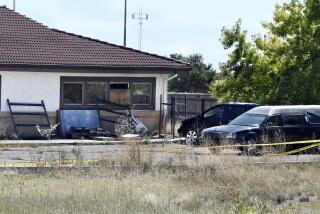Couple Indicted in Art Smuggling Investigation
A Los Angeles federal grand jury indicted a husband and wife Thursday for allegedly conspiring to smuggle pre-Columbian art into the country, officials said.
David Rand Swetnam, 31, and Jacquelyn Swetnam, 30, former Santa Barbara art restorers, are charged with conspiracy, making false statements to U.S. Customs Service agents and receiving and procuring smuggled goods, according to Assistant U.S. Atty. Spurgeon Smith.
Among the items--all from Peru--authorities said, were a miniature mortar in the form of a cat carved from black stone, a pair of gold ear spools decorated with turquoise and shell, a stirrup spout vessel in shape of a seated figure whose head rests upside down and backwards on his knees and another vessel shaped like a man wearing a jaguar mask.
The two are scheduled to appear for arraignment Nov. 28 before U.S. Magistrate Volney Brown. If convicted, they could face a maximum penalty of five years’ imprisonment and $250,000 in fines on each count of the 10-count indictment.
The indictments are part of a widespread California investigation that involves the activities of dealers and collectors on three continents. A series of eight raids earlier this year in Los Angeles, San Luis Obispo and Santa Barbara netted 1,137 art objects.
According to the charges, David Swetnam allegedly first shipped the items from Peru to London. The Swetnams paid Michael Kelly, an English citizen who lives in Los Angeles, $5,000 to receive and store the artifacts in London at the home of his mother, Nancy Kelly, officials said.
Nancy Kelly allegedly sent two shipments of the artifacts to her son in Los Angeles in November, 1986, and May, 1987, declaring them part of her son’s “personal effects,” officials said. In August, 1987, Swetnam arranged to have other artifacts shipped to Kelly, the indictment said.
The indictment is part of a crackdown on the black market sale of pre-Columbian art. As interest in ancient American cultures has grown, officials say, so have the smuggling and illegal trading of them. The demand has been created by a voracious market in Europe, Japan and the United States, according to archeological experts.
A 1971 U.N. convention banning transfer of such cultural antiquities has been signed by 54 nations, including the United States.
The defendants could not be reached for comment.
More to Read
Sign up for Essential California
The most important California stories and recommendations in your inbox every morning.
You may occasionally receive promotional content from the Los Angeles Times.










